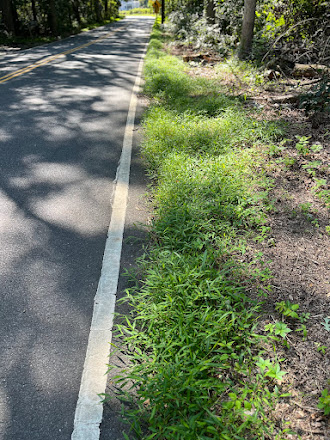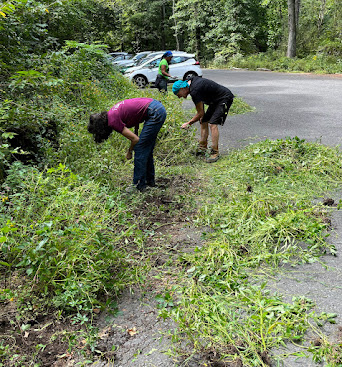Not everyone gets to discover and report on a new invasive species in one's adopted home town. Though there were a couple kinds of invasive plants that I caught early enough to hopefully keep from spreading through town--thorny mile-a-minute and more recently the dreaded common buckthorn--this particular discovery is different, in that people have yet to agree on what it is. How strange it can feel, in a time when the internet can instantly tell you everything about everything, to find a plant to which no one can with certainty give a name.
I first encountered a single specimen of the mystery tree while conducting a plant inventory in Roger's Refuge in 2007. Only in the past few years have I found it proliferating in Herrontown Woods and Autumn Hill Reservation.Another, Bin-Bin Liu, was also apparently unable to assist. John laments that botanists now trained in phylogenomics can identify gene sequences but not the actual physical plants themselves.
There have been various species names thrown at the mystery tree--lurida, lucida, arguta--but none clearly stick thus far. Through Mike Van Clef, I learned of Jean Epiphan, a northern NJ plant expert at Rutgers, who had arrived at the species name "parvifolia", and even came up with a common name, "littleleaf photinia." Originally introduced in 1908 at the Arnold Arboretum," it's popping up in Morris County and, according to Jean, matches our mystery tree in Princeton. She has not seen it being sold in nurseries, and speculates that it is spreading from specimens in old estates. She sent a couple links (here and here) with descriptions, and a mention of it in Dirr's encyclopedic Manual of Landscape Plants.
Some sticking points, though, are that the link she sent to a photo has now gone dead, and the description is of a shrub less than ten feet high. A photo sent by Pat Coleman from Bowman's Hill Wildflower Preserve also matched our mystery tree in Princeton, but no word as yet whether they've come up with a name.
One thing to call the mystery tree is pretty, as are many invasive shrubs, both when they bloom and in the fall. This fall in particular, Autumn Hill Reservation was a jubilant jumble of colorful invasive shrubs, led by the bright red of winged euonymus, joined by the rich colorations of Linden viburnum and the golden yellows of the asian photinia Even the lowly privet got into the color game with an appealing dark bronze.When surrounded by such a dazzling visual display, it takes work to remind oneself that something important is being lost as these introduced species gain dominance in the understory. Their success and dominance is enabled in part through being rejected by deer, which prefer a diet of native plants. Thus, our eyes are well fed while the wildlife find themselves living in an increasingly inedible forest.
As we lose many of the native trees dominating the canopy--chestnut, elm, ash, and now the beloved beech--the extra light reaching the understory drives the extravagant growth of nonnative shrubs. Surrounded by such a thorough invasion of nonnative growth, it is extraordinarily intimidating to contemplate the work involved to shift the balance back to the spicebush, blackhaw viburnums, blueberries, hollies, sumacs, and other natives currently getting smothered beneath the rising tide.
Native shrubs and trees don't exactly lack color. Here's a dogwood that was mixed in and easily confused with the mystery invasive. Note the way the leaves are paired rather than arising one at a time along the stem.- Rogers Refuge, Herrontown Woods, and Autumn Hill in Princeton
- Possible sighting in the Institute Woods in Princeton
- Bowman's Hill Wildflower Preserve
- Jockey Hollow and the NJ Brigade Area in Morris County
- Tourne Park, in Boonton
"Thanks for alerting us to this newly naturalized species. One of the best resources for documentation of plants on a global scale is GBIF. Reviewing the gallery of specimens online, the name leaves to appear to bear a resemblance to Photinia parviflora. https://www.gbif.org/occurrence/gallery?taxon_key=5363981"Each photo at the link bears the name C.K. Schneid. Look at the wikipedia page for Camillo Karl Schneider and you'll find that he was a German botanist who traveled to China in 1913 to collect plants and seeds. His next stop was the Arnold Arboretum in Boston, where the species is said to have been introduced five years earlier by Wilson in 1908.
Applied name Photinia parvifolia (Pritz.) C.K.Schneid.
Accepted name Pourthiaea parviflora (Cardot) Iketani & H.Ohashi


















































